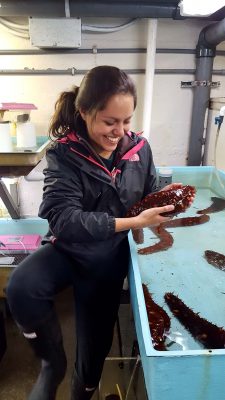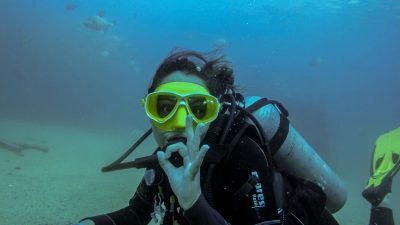 Ana Pozas is a first-year Master of Science student at the Institute for the Oceans and Fisheries (IOF). She’s doing her research under the supervision of IOF assistant professor David Rosen in the Marine Mammal Energetics and Nutrition (MMEAN) lab, studying the diets of California sea lions. After finishing her biology degree at UBC (where she had the chance to do a project with Dr. Rosen at the Vancouver Aquarium), Ana was offered a position at the MMEAN research unit to complete her master’s degree.
Ana Pozas is a first-year Master of Science student at the Institute for the Oceans and Fisheries (IOF). She’s doing her research under the supervision of IOF assistant professor David Rosen in the Marine Mammal Energetics and Nutrition (MMEAN) lab, studying the diets of California sea lions. After finishing her biology degree at UBC (where she had the chance to do a project with Dr. Rosen at the Vancouver Aquarium), Ana was offered a position at the MMEAN research unit to complete her master’s degree.
What made you interested in studying sea lions?
People say this a lot, but they’re kind of the dogs of the sea. It’s very easy for people to connect with dogs – they’re something familiar that most people love and are interested in, which can carry through to sea lions. To me that always reminds me that the ocean is not such a scary place and that there’s so much to learn still, and I hope others can also see that. They can represent something close to home, but in the marine world.
Did you have much first-hand experience with sea lions before coming to the IOF?
During my undergrad program, I did a four-month co-op with The Nature Conservancy in the Gulf of California in Mexico. That was a great experience where I realized that I really liked marine biology and conservation. That’s where I had contact with California sea lions, which was in the wild, first-hand, swimming with them, but nothing to do with research until my project with Dr. Rosen at UBC.
When I worked with Dr. Rosen for one of my course projects, we had to do a behavioural research study. We did 50 hours’ worth of observations of the species that we had chosen. I focused on the sea lions at the Aquarium. I watched and recorded their behaviour, analyzed data, and answered some questions. It was nice staying connected to the animals I had seen in the wild.
What research are you doing now at the IOF?
 Unfortunately, I am unable to go out and do fieldwork because of COVID. I’m working with data that already exists; doing a meta-analysis of data on the diet and population changes of California sea lion rookeries in the Gulf of California and the Pacific coast.
Unfortunately, I am unable to go out and do fieldwork because of COVID. I’m working with data that already exists; doing a meta-analysis of data on the diet and population changes of California sea lion rookeries in the Gulf of California and the Pacific coast.
While many populations on the coast are increasing, in the Gulf they’re decreasing. I’m working with a researcher in Mexico who has a lot of diet data that I’m going to be combining with population data to see how the zones differ in terms of population and to understand whether the population differences have something to do with the quality of the fish they’re eating.
What can you tell me about your time at the IOF so far?
I feel like right now as a first-year student it’s nice to be taking the FISH 500 course and feel that professors are rooting for us and for me. They are very aware that we’re starting off, beginning to think about big projects, and exploring different areas with our own interests and skills.
Related story: SPOTLIGHT: Marine Mammal Energetics and Nutrition Lab carries on with research despite COVID-19 setbacks
Tags: David Rosen, IOF students, Marine Mammal Research Unit, marine mammals, MMean Lab, Pacific, sea lions